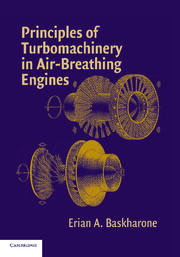Book contents
- Frontmatter
- Contents
- Preface
- 1 Introduction to Gas-Turbine Engines
- 2 Overview of Turbomachinery Nomenclature
- 3 Aerothermodynamics of Turbomachines and Design-Related Topics
- 4 Energy Transfer between a Fluid and a Rotor
- 5 Dimensional Analysis, Maps, and Specific Speed
- 6 Radial-Equilibrium Theory
- 7 Polytropic (Small-Stage) Efficiency
- 8 Axial-Flow Turbines
- 9 Axial-Flow Compressors
- 10 Radial-Inflow Turbines
- 11 Centrifugal Compressors
- 12 Turbine-Compressor Matching
- References
- Index
1 - Introduction to Gas-Turbine Engines
Published online by Cambridge University Press: 05 September 2012
- Frontmatter
- Contents
- Preface
- 1 Introduction to Gas-Turbine Engines
- 2 Overview of Turbomachinery Nomenclature
- 3 Aerothermodynamics of Turbomachines and Design-Related Topics
- 4 Energy Transfer between a Fluid and a Rotor
- 5 Dimensional Analysis, Maps, and Specific Speed
- 6 Radial-Equilibrium Theory
- 7 Polytropic (Small-Stage) Efficiency
- 8 Axial-Flow Turbines
- 9 Axial-Flow Compressors
- 10 Radial-Inflow Turbines
- 11 Centrifugal Compressors
- 12 Turbine-Compressor Matching
- References
- Index
Summary
Definition
A gas turbine engine is a device that is designed to convert the thermal energy of a fuel into some form of useful power, such as mechanical (or shaft) power or a highspeed thrust of a jet. The engine consists, basically, of a gas generator and a power-conversion section, as shown in Figures 1.1 and 1.2.
As is clear in these figures, the gas generator consists of the compressor, combustor, and turbine sections. In this assembly, the turbine extracts shaft power to at least drive the compressor, which is the case of a turbojet. Typically, in most other applications, the turbine will extract more shaft work by comparison. The excess amount in this case will be transmitted to a ducted fan (turbofan engine) or a propeller (turboprop engine), as seen in Figure 1.2. However, the shaft work may also be utilized in supplying direct shaft work, or producing electricity in the case of a power plant or an auxiliary power unit (Fig. 1.1). The fact, in light of Figures 1.1 through 1.5, is that different types of gas-turbine engines clearly result from adding various inlet and exit components, to the gas generator. An always interesting component in this context is the thrust-augmentation devices known as afterburners in a special class of advanced propulsion systems (Fig. 1.4).
Gas-turbine engines are exclusively used to power airplanes because of their high power-to-weight ratio. They have also been used for electric-power generation in pipeline-compressor drives, as well as to propel trucks and tanks. In fact, it would be unwise to say that all possible turbomachinery applications have already been explored.
- Type
- Chapter
- Information
- Publisher: Cambridge University PressPrint publication year: 2006



